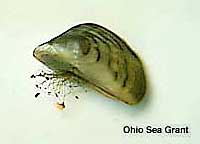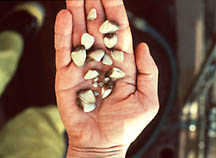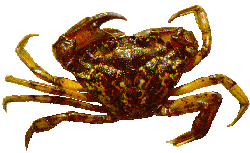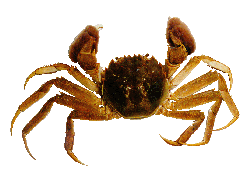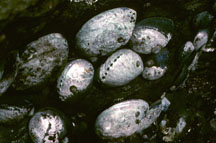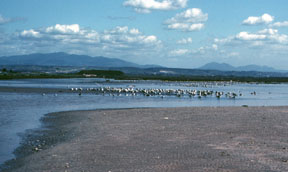 |
|||||||||
skip to content |
|||||||||
Aquatic Nuisance Species
California Sea Grant College System
Aquatic nuisance species may constitute the largest single threat to the biological diversity of the world's coastal waters. California, with its 1,100-mile coastline, has encountered numerous problems with these uninvited "guests" that can be costly in both economic and environmental terms. Problem species range from a tiny sabellid worm that has devastated the abalone aquaculture industry to an alien cordgrass that threatens to destroy essential mudflat habitat for birds and fish. The San Francisco Estuary alone is now host to more than 200 aquatic nuisance species (ANS), also referred to as nonindigenous species (NIS).
Aquatic nuisance species may constitute the largest single threat to the biological diversity of the world's coastal waters. |
California Sea Grant has hosted and sponsored two workshops on ANS: the "Eighth International Zebra Mussel and Aquatic Nuisance Species Conference" in 1998, and "Marine and Aquatic Nonindigenous Species in California: An Assessment of Current Status and Research Needs" in 1996. They were attended by researchers, resource managers, and representatives of state agencies and industry. Presentations focused on biological invasions, including species of concern in California, such as the European green and Chinese mitten crabs, Asian clam, zebra mussel, ballast water management and policy, sabellid polychaete worm, and the spread of nonindigenous aquatic plants, all of which have the potential to adversely affect coastal and freshwater aquatic ecosystems in California.
California Sea Grant College System researchers and marine advisors have undertaken a number of public education and research projects on behalf of the state and region to effectively deal with some of these problem species, but much more work remains to be done. Damage estimates to industry and the environment already range in the millions of dollars. With continued efforts, future economic and environmental losses can be significantly reduced.
Zebra mussels
|
Zebra mussel (Dreissena polymorpha) Photo courtesy of Ohio Sea Grant College Program. |
A major concern in the West is preventing the introduction and spread of the zebra mussel (Dreissena polymorpha), an eastern European native thought to have been transported in the ballast water of ships originating in freshwater European ports. Since its introduction into the Great Lakes region in the 1980s, this aggressive species has spread to 20 states and two Canadian provinces. California Sea Grant Extension Program (SGEP) Marine Advisor Jodi Cassell has initiated projects to educate the public, particularly recreational boaters, on how to prevent its spread into Western states by unintentional transport on recreational boats and fishing gear.
Cassell targeted boaters in the 12-county San Francisco Bay-Delta region with educational materials including two brochures, dock and boat ramp signs, and a leadership training package from Minnesota Sea Grant (a printed manual, slide and audiotape set, and a videotape). The materials were adapted to include a generic focus on the threat of zebra mussels to ecological and water delivery systems in Western states.
The second major component of the project was a random mail survey. This was conducted to evaluate the base knowledge and awareness among boaters in the 12-county San Francisco Bay-Delta region regarding aquatic nuisance species issues. The survey also provided information on the boating habits and activities of boaters in the region and an assessment of activities that may contribute to the spread of zebra mussels. These activities include time spent boating in freshwater areas, intrastate transport of vessels, and time spent boating in states that have zebra mussels.
As this was the first major effort to initiate proactive zebra mussel educational programming in the West, the lessons learned and findings from the project will be useful to other Western states which begin to develop programs in this area of concern.
In related projects, a zebra mussel information flyer was created at the invitation of the California Department of Boating and Waterways. It was included with all recreational vessel registration forms (approximately 1 million) in California. Funding from the U.S. Fish and Wildlife Service and California Sea Grant will be used to develop a regional program that will educate recreational boaters about zebra mussel risk and preventative measures.
|
Asian clam (Potamocorbula amurensis) introduced into San Francisco Bay in 1986 Photo courtesy of U.S. Geological Survey |
Asian clam
The Asian clam Potamocorbula amurensis threatens to alter the ecosystems which it invades by altering the food web. In northern San Francisco Bay, the clam has eliminated the annual summer phytoplankton bloom by its ability to filter the water column at least once per day. P. amurensis is also thought responsible for a reduction in particulate organic carbon. With less food available for larval and other benthic filter feeders, the relative populations of native species could shift.
European green crab
|
European green crab (Carcinus maenas) Photo courtesy of California Interagency Ecological Program |
The European green crab (Carcinus maenas) population has expanded rapidly since their introduction to California in 1989. It has a reported range from Monterey Bay to southern Washington. Concerns have been raised that the crab will negatively impact the Central California population of Dungeness crab, which utilize the San Francisco Estuary as a nursery. Also a European native, it was first found on the U.S. East Coast during the last century. Again, ballast water is suspected as being a likely vector, along with shipments of live seafood or bait. Green crab predation has resulted in significant reductions in native bivalves and crustaceans in Bodega Bay. The green crab is also suspected of preying upon juvenile Dungeness crabs, cultured clams and oysters.
To learn more about the European green crab, visit the Environmental News Network. or Oregon Sea Grant's web site.
Chinese mitten crab
Chinese mitten crab (Eriocheir sinensis) Photo courtesy of California Interagency Ecological Program |
The Chinese mitten crab was probably introduced to San Francisco South Bay in the late 1980s, but is not yet common in the northern reach of the Estuary. Mitten crab juveniles migrate to fresh water to rear, burrowing in banks and levees; in South Bay sloughs, mitten crab burrow densities as high as 130 per 10 linear feet of bank have been reported. They may compete with crayfish for burrows, but more importantly, their burrowing activity possibly undermines banks and levees and accelerates erosion rates.
Sabellid polychaete worm
California Sea Grant researchers Carolynn S. Culver and Armand M. Kuris and abalone culturist Benjamin Beede have written a book, "Identification and Management of the Exotic Sabellid Pest in California Cultured Abalone" 1997, that discusses the tiny worm that has devastated California's abalone aquaculture industry.
|
Abalone (top) |
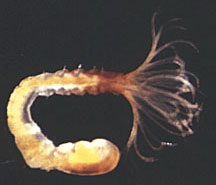 |
The sabellid worm infests the shell of its host, causing slowed growth and often shell deformation, resulting in production delays and economic loss to growers.
Culver and Kuris recently completed a successful project aimed at eradicating the sabellid from a coastal area (Cayucos) where it had been transmitted to native gastropods. This is perhaps the first successful eradication of a well-established introduced pest in a marine environment.
Cordgrass
The spread of the Atlantic saltmarsh smooth cordgrass, Spartina alterniflora, has the potential to alter the California landscape through its ability to eradicate native cordgrass, S. foliosa, and encroach on open mudflats. California Sea Grant researcher Donald Strong at University of California, Davis, has reported dense cordgrass stands formed by S. alterniflora over open mudflat habitats, posing a threat to invertebrates, fish and waterfowl, and even commercial fish and crab populations. Spartina alterniflora has already played a role in flooding in Alameda and Contra Costa counties in California by blocking flood-control channels. For more information on Strong's research, visit the Spartina Lab.
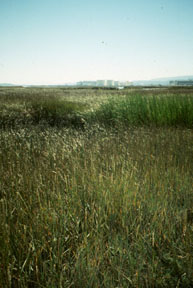 |
(Left) Spartina alterniflora clone |
At the January 1999 AAAS meeting in Anaheim, California, U.S. Secretary of the Interior Bruce Babbitt called for global cooperation, funding increases and more formal enforcement mechanisms to stop the flow of exotic species. "The green crab has begun to infest Pacific coastal waters devouring everything from commercially valuable oysters and clams to barnacles, algae and snails. Spartina from Atlantic coastal estuaries has choked Willapa Bay and decimated the shellfish industry. In the San Francisco Bay, there are more than 30 species of exotic fish -- Asian goby, Atlantic shad, Mississippi catfish, carp, bass, perch, sunfish and goldfish -- have been found."
But the damage has not only been in the U.S. The Environmental News Network reports that ballast water from ships leaving the United States in the early 1980s transported a small, luminescent blob called Leidy's comb jelly, which was discharged weeks later into the Black Sea. With no predators, it rapidly spread into one of the most intense marine invasions ever recorded, nearly wiping out anchovies and other fisheries.
The adverse effects of ANS can include economic impacts such as damage to municipal water systems, loss of commercial fishing and recreational opportunities, and potential disruptions of entire ecosystems. Continued work needs to be done to inform the general public about how they can help prevent the spread of ANS and to generate the scientific data necessary for informed management decisions.
For further information about aquatic nuisance species, visit National Sea Grant's Nonindigenous Species web site or Sea Grant's National Zebra Mussel and Aquatic Nuisance Species Clearing House.
|
The California Sea Grant College System is a statewide, multi-university program of marine research, extension services, and educational activities administered by the University of California and headquartered at Scripps Institution of Oceanography, University of California, San Diego. It is funded by the National Oceanic and Atmospheric Administration, U.S. Department of Commerce, in partnership with the State of California and private industry. Further information may be found at http://www-csgc.ucsd.edu/ |
CLIMATE · OCEANS, GREAT LAKES, and COASTS · WEATHER
and AIR QUALITY
ABOUT US · RESEARCH
PROGRAMS · EDUCATION · HOME
